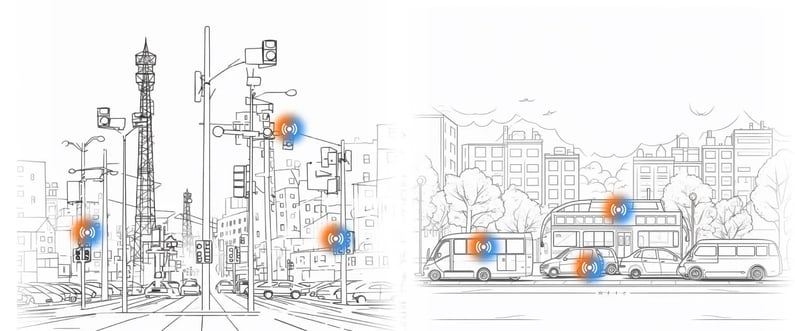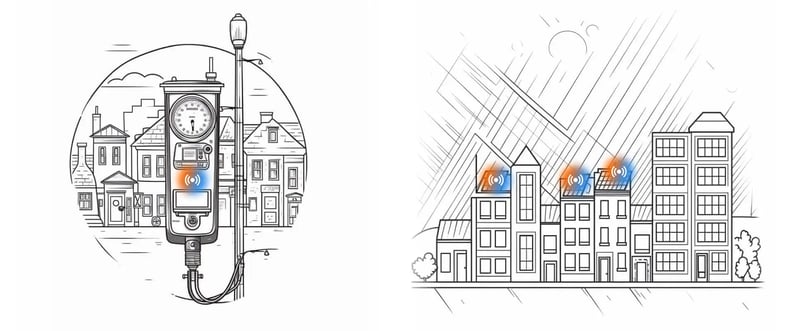In today's progressive cities, Internet of Things (IoT) devices are revolutionizing the way we live, enhancing efficiency, sustainability, and the overall quality of life for residents. These innovative cities are harnessing the power of IoT to seamlessly integrate different systems and services, creating a safer, more connected, and eco-friendly urban environment.
At the heart of a smart city, IoT devices play a pivotal role in enabling seamless operation and efficient management. Equipped with sensors, actuators, and advanced connectivity, these devices have the remarkable ability to instantly gather and share data. In this article, we will delve into the key applications of IoT in smart cities.
Let's explore the transformative potential of IoT in creating smarter and more sustainable cities.
Smart Infrastructure
In a smart city, IoT devices are used to monitor infrastructure like bridges, roads, and buildings in real time for maintenance. By using sensors and monitoring systems, cities can detect and fix structural weaknesses promptly, ensuring the safety and durability of essential assets.
One of the key applications of IoT in smart infrastructure is structural health monitoring. Sensors embedded in bridges, for instance, can measure parameters such as vibrations, strain, and deformation. These sensors continuously collect and transmit data wirelessly to a centralized system. Through real-time analysis and machine learning algorithms, any signs of structural damage or weaknesses can be detected, even in the early stages, allowing authorities to take prompt action.
The benefits of using IoT devices in smart infrastructure are numerous. First, they enable continuous monitoring, eliminating the need for manual inspections conducted at infrequent intervals. This means that potential issues can be identified early, reducing the risk of accidents or disruptions. IoT devices give a better knowledge of infrastructure conditions by collecting and analyzing data in real time.
Moreover, the data collected from IoT sensors helps cities optimize infrastructure management and maintenance. By analyzing the patterns and trends within the collected data, authorities can identify recurring issues or areas prone to problems, prioritizing maintenance efforts and allocating resources efficiently.

Traffic Management
In the realm of smart cities, traffic management plays a crucial role in ensuring smooth transportation and reducing congestion. IoT-enabled traffic management systems leverage the power of connected devices to monitor traffic flow, control traffic signals, and optimize transportation routes. As a result, cities have improved public transportation services and enhanced overall mobility for citizens.
One of the key components of IoT-enabled traffic management systems is real-time traffic monitoring. Using sensors in roads, intersections, and parking lots, these systems gather data on traffic, vehicle speed, and other important factors. By constantly analyzing this data, traffic management authorities can gain valuable insights into the current state of traffic within the city.
With the help of IoT, traffic signals can also become more intelligent and adaptive. Traffic lights can change their timing based on current traffic conditions by using sensors and communication devices.
Another crucial aspect of IoT-enabled traffic management is the optimization of transportation routes. Cities can provide up-to-date information on the most efficient routes to people's destinations. This is done by utilizing real-time traffic data and integrating it with navigation systems. Navigation apps and in-car systems can use this data to guide drivers on less crowded routes.
Public transportation services can also benefit from IoT-enabled traffic management systems. By equipping buses, trains, and trams with IoT devices, transportation authorities can obtain real-time information about the location, occupancy, and performance of public transport vehicles. They can use this data to optimize routes, adjust schedules, and improve the overall reliability and convenience of public transportation systems. In addition, passengers can receive live updates through mobile applications or electronic signs at stations.
To further enhance traffic management, IoT devices can also be used for parking management. By deploying smart parking systems that include sensors in parking lots or on-street parking spaces, cities can provide real-time information about available parking spaces to drivers. This reduces the time spent searching for parking, minimizes congestion caused by circling vehicles, and enhances the overall parking experience for citizens.

Waste Management
Managing waste is important for keeping cities clean and sustainable. IoT devices have made waste collection and disposal cheaper and more efficient. IoT sensors in garbage bins allow waste management to track bin fill levels in real time. This helps improve collection routes and reduces unnecessary pickups.
Usually, garbage trucks stick to set schedules to collect trash from specific places, regardless of how full the bins are. This approach often results in inefficient use of resources, as some bins may be nearly empty while others may be overflowing. With IoT sensors, waste management providers can collect data on the fill levels of bins remotely and accurately.
IoT waste systems can track bin levels and send instant reports and alerts to authorities. Thanks to this authorities optimize collection routes based on actual demand, ensuring that collection trucks visit bins only when necessary. It saves time, fuel, and labor costs while reducing noise, air pollution, and traffic congestion from unnecessary collection rounds.
In addition to optimizing collection routes, IoT devices can also facilitate remote monitoring of waste management infrastructure. For instance, waste containers can be equipped with environmental sensors that track factors like temperature, humidity, and odor levels. This data can be analyzed to identify unusual patterns or detect potential hazards such as fire risk or leakage. By receiving alerts in such situations, waste management authorities can take prompt actions, improving safety and minimizing environmental risks.
Another advantage of IoT-enabled waste management systems is the ability to implement dynamic pricing models. By monitoring the fill levels of bins in real time, authorities can introduce variable pricing structures. Residents are then billed according to the actual waste they generate.

Energy Management
Energy management plays a vital role in reducing energy consumption, optimizing resource utilization, and mitigating the environmental impact of power generation. With the advent of the Internet of Things (IoT), energy systems have become smarter and more efficient. It allows better monitoring, control, and integration of renewable energy sources.
One of the key components of IoT-based energy management is the use of smart meters. These devices track and record energy consumption data in real time, providing users with detailed insights into their electricity usage patterns. With the help of smart meters, users can implement energy-saving strategies. They can adjust settings or schedule operations during off-peak hours, resulting in reduced energy waste and lower utility bills.
In addition, IoT technology plays a crucial role in integrating renewable energy sources into the existing energy grid. Renewable energy, such as solar photovoltaic panels and wind turbines, often generates intermittent power.
IoT devices can enable smart grid functionalities that enable better monitoring and control of renewable energy generation. For example, by integrating IoT sensors and communication systems into solar panels, information about power output, sun exposure, and potential faults can be transmitted to the grid operator in real time. This facilitates efficient utilization of renewable energy and streamlines grid operations.
Furthermore, IoT systems can enable the remote monitoring and control of energy infrastructure. Sensors installed in power plants, substations, and distribution lines provide real-time data on various operational parameters such as temperature, voltage levels, and equipment performance. This allows operators to track system health, identify potential failures, and perform proactive maintenance. By detecting and addressing issues promptly, IoT-based energy management systems enhance the reliability, efficiency, and safety of energy grids.

Environmental Monitoring
The Internet of Things (IoT) has revolutionized environmental monitoring by providing real-time data on various environmental factors. One of the key areas where IoT has made significant contributions is in the monitoring and management of air quality. IoT devices, equipped with sensors, can measure pollutant levels such as particulate matter, carbon monoxide, nitrogen dioxide, and ozone. By deploying these devices throughout a city or region, authorities can create a comprehensive real-time air quality monitoring network.
IoT devices collect data to find pollution hotspots, monitor pollution trends, and evaluate pollution reduction efforts. City authorities can use this information to take proactive measures to improve air quality and public health. In areas with high air pollution, authorities can take action to improve the situation. These actions may include managing traffic, controlling emissions, or installing air purifiers.
Noise pollution is another critical environmental factor that IoT can monitor and manage. IoT-based noise sensors can continuously monitor the noise levels in urban areas, public spaces, or construction sites. This data can help identify areas where noise levels exceed acceptable limits and take appropriate measures to reduce noise pollution. Authorities can step in and enforce rules if a construction site near homes makes too much noise.
In addition to air and noise monitoring, IoT technology also plays a crucial role in weather pattern monitoring. IoT weather sensors can collect data such as temperature, humidity, barometric pressure, rainfall, and wind speed. This information is not only valuable for weather prediction but also for environmental monitoring.
Furthermore, the monitoring and management of environmental factors using IoT technology are not limited to cities alone. IoT devices can be deployed in rural areas, forests, and marine ecosystems to monitor and preserve the environment. For example, remote sensors can monitor water quality in rivers, lakes, and oceans, helping to detect pollution, harmful algal blooms, or water contamination, and enabling prompt actions to protect aquatic life and ensure clean water resources.

Public Safety
The use of IoT devices in public safety has revolutionized the way cities and communities manage security and emergency response systems. One of the primary applications of IoT in this domain is the deployment of surveillance cameras equipped with advanced features like facial recognition, object detection, and video analytics. These cameras can monitor public areas, transportation hubs, and critical infrastructure, providing real-time monitoring and analysis of activities.
The information from these smart cameras can be analyzed instantly using AI algorithms. This allows for the identification of potential security threats, criminal activities, or unusual behaviors. For example, if a surveillance camera with facial recognition capabilities detects a person on a watchlist or someone displaying suspicious behavior, an alert can be sent to law enforcement agencies instantly. This fast response improves security operations, helping to stop crimes before they happen.
In addition to surveillance cameras, IoT devices can also support emergency response systems. For instance, IoT devices in a city let people report emergencies directly to response centers, improving communication and safety.
These devices give location, audio or video, and other info to help emergency services respond faster and more accurately. Moreover, IoT sensors can be used in wearable devices or public infrastructure to detect dangers like fires, gas leaks, or structural failures. This helps with rapid response and evacuation procedures.
Furthermore, IoT devices can be integrated with existing emergency management systems, enabling more effective coordination and response during crises or natural disasters. For instance, sensors deployed in disaster-prone areas can detect events like earthquakes, floods, or hurricanes in real time. This allows for immediate alerts to be sent to emergency response teams, who can then take the necessary actions to protect lives and infrastructure.

Overall, IoT devices play a critical role in transforming cities into smart cities. By connecting and analyzing data from various sources, smart cities can improve efficiency, sustainability, and the overall quality of life for their residents.


